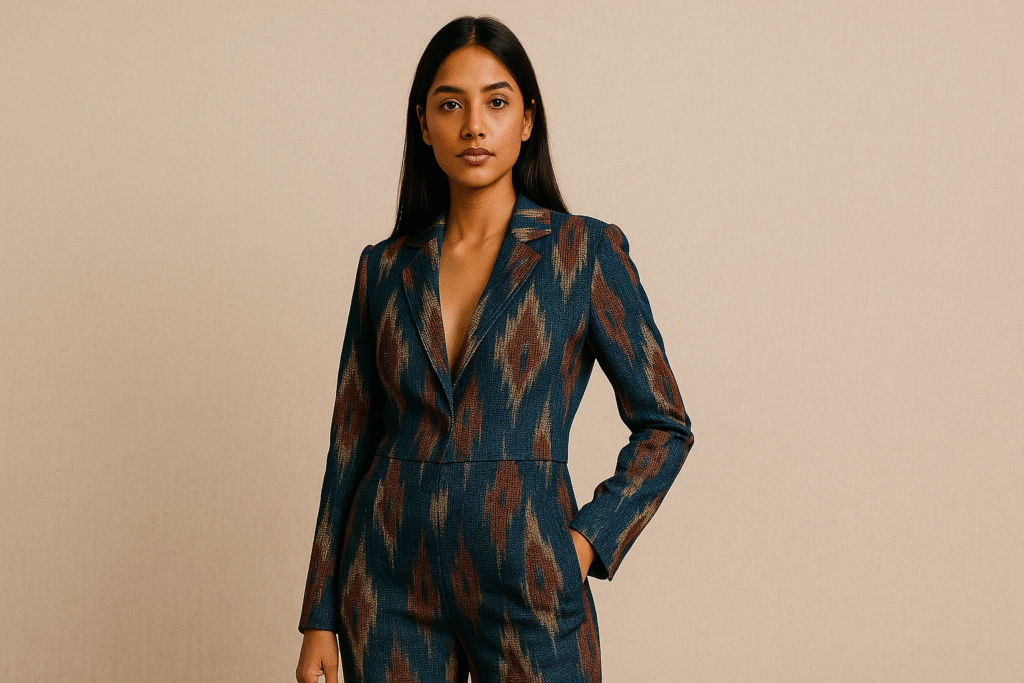In a world racing toward the future, where trends rise and fall in the blink of an eye, something remarkable is happening in fashion. Designers are looking back—not to imitate, but to build. Across global runways, textile workshops, and independent labels, a quiet revolution is weaving the past into the future. It’s called hybrid design, and it’s redefining how we see tradition, especially in the realm of heritage weaves fashion.

What Is Heritage Weaves Fashion?
Heritage weaves fashion isn’t just a look; it’s a language. Rooted in centuries-old textile traditions—like India’s Kanjeevaram, Ghana’s Kente, Japan’s Kasuri, or Peru’s Alpaca weaving—these fabrics carry stories. Each thread is dyed with meaning: of place, of people, of politics, of prayer. They were once local, artisanal, and functional. Now, they’re being reimagined for high fashion, streetwear, and experimental design.
When we talk about heritage weaves fashion, we’re talking about techniques that have survived colonialism, industrialization, and globalization. We’re talking about looms operated by human hands, dyes made from soil and bark, and patterns that map memory. But more and more, we’re also talking about how these age-old crafts are being cut, draped, and styled in new silhouettes—crops, jackets, tailored trousers, and gender-neutral designs.
This is the heart of hybrid design: the collision of old and new, craft and cut, local and global.
Why Hybrid Design Matters
Hybrid design isn’t a trend. It’s a counter-narrative.
Fashion has long suffered from cultural appropriation. Mainstream brands have borrowed aesthetics from indigenous and traditional cultures without credit or compensation. But hybrid design, at its best, reverses that dynamic. It’s collaborative. It’s conscious. It gives agency back to the artisan.
This matters, because when you wear something made from a heritage weaves but cut in a modern form, you’re not just wearing a piece of clothing. You’re wearing a bridge. Between generations. Between continents. Between heritage and innovation.
Take for example a sharply tailored blazer made from Bògòlanfini, or mud cloth, from Mali. The shape is Western. The fabric is deeply African. Together, they tell a story that’s both respectful and radical. That’s the power of hybrid design.
Global Case Studies in Hybrid Style
India: The Reinvention of the Sari
India is a living archive of woven traditions—Chanderi, Jamdani, Ikat, and more. For centuries, these fabrics were mostly worn in their traditional forms. But a new generation of Indian designers—like Anavila Misra, Raw Mango, and Abraham & Thakore—is reshaping the narrative.
They’re using heritage weaves not just for saris but for trench coats, culottes, co-ord sets, and sharply tailored menswear. Anavila’s linen saris, for example, are minimal, earthy, and designed for movement—combining village craft with urban comfort.
The weaves stay rooted. The cuts fly forward. That’s hybrid design.
Ghana: Kente in Contemporary Streetwear
Kente cloth, with its geometric brilliance and royal symbolism, was once reserved for special occasions. Now, young designers in Ghana and the diaspora—like Studio 189 and Atto Tetteh—are using Kente in bomber jackets, jumpsuits, and sneakers.
This isn’t dilution; it’s evolution. It’s taking the soul of Kente and giving it new bodies to live in. It’s heritage weaves fashion reborn through a modern lens—one that’s proudly African, unapologetically stylish, and politically sharp.
Japan: Boro and Avant-Garde Minimalism
Japan’s Boro textiles were originally made by peasants—patched, repaired, and repurposed indigo fabrics born of necessity. Today, Boro influences some of the most avant-garde designers on the planet.
Labels like Kapital and Visvim are infusing traditional Sashiko stitching and faded indigo textures into progressive silhouettes. Meanwhile, brands like Yohji Yamamoto and Issey Miyake nod to these textile traditions in their own radical constructions. The result is a fashion that is at once ghostly and futuristic.
Cultural Reclamation Through Fashion
The resurgence of heritage weaves fashion is more than aesthetic. It’s political. For many communities, especially postcolonial ones, reclaiming textile traditions is a form of resistance.
By re-centering indigenous craft in fashion, hybrid design shifts power. It tells a different story—one where beauty isn’t imported but inherited. One where local knowledge is global capital.
This reclamation is particularly visible in indigenous-led brands. In Mexico, designers are working directly with Zapotec and Mixtec weavers to create contemporary garments that honor regional dyeing techniques. In Guatemala, Mayan artisans are launching their own lines instead of working behind the scenes for export labels.
They’re not just contributing to fashion—they’re shaping it.
Sustainability in the Warp and Weft
Another reason hybrid design is gaining traction? Sustainability.
Mass fashion is drowning the planet in synthetic fibers and overproduction. But heritage weaves, by nature, are slow-made. They use natural materials, require less energy, and support local economies. When paired with minimalist, versatile cuts, they also encourage longer wear and conscious consumption.
Hybrid design, then, is not just a stylistic innovation—it’s an ecological one. A textile woven in Assam, stitched into a modern jacket, worn across seasons and generations—that’s fashion with a future.
Challenges and Ethical Considerations
Of course, not all hybrid design is ethical. There’s a fine line between homage and exploitation. When heritage weaves are used without credit, fair pay, or cultural sensitivity, they become commodities rather than collaborations.
Designers, consumers, and brands have a responsibility to go deeper. Know where your fabric comes from. Know who made it. Ask what stories are being told—and who gets to tell them.
True hybrid design is built on relationships. It requires patience, listening, and mutual respect. It’s not just about aesthetics. It’s about ethics.
The Future: Design as Dialogue
The future of fashion lies not in erasing the past but in remixing it.
In a time of digital saturation and cultural flattening, heritage weaves fashion offers depth. It reminds us that identity is layered. That beauty can be ancient and avant-garde. That tradition isn’t static—it’s a conversation.
Hybrid design makes that conversation visible. It asks: What happens when a Ghanaian kente meets a Parisian cut? When a Filipino Inabel meets a Scandinavian silhouette? When a Navajo pattern meets modular streetwear?
What happens is transformation.
Not everything old needs to be preserved in a museum. Some things deserve to be worn, lived in, and remade—again and again—with respect and imagination.
Closing Thread
Heritage weaves fashion is a revival, but not a nostalgic one. It’s a blueprint for the future, where fashion doesn’t just dress bodies but expresses ancestry, geography, and philosophy. It’s proof that sustainability can be stylish, that innovation can be cultural, and that art can be worn.
Hybrid design doesn’t choose between the loom and the runway. It walks boldly between them, stitching stories that stretch across time.
And in that tension—in that weaves—we find fashion that finally feels human again.




Add comment